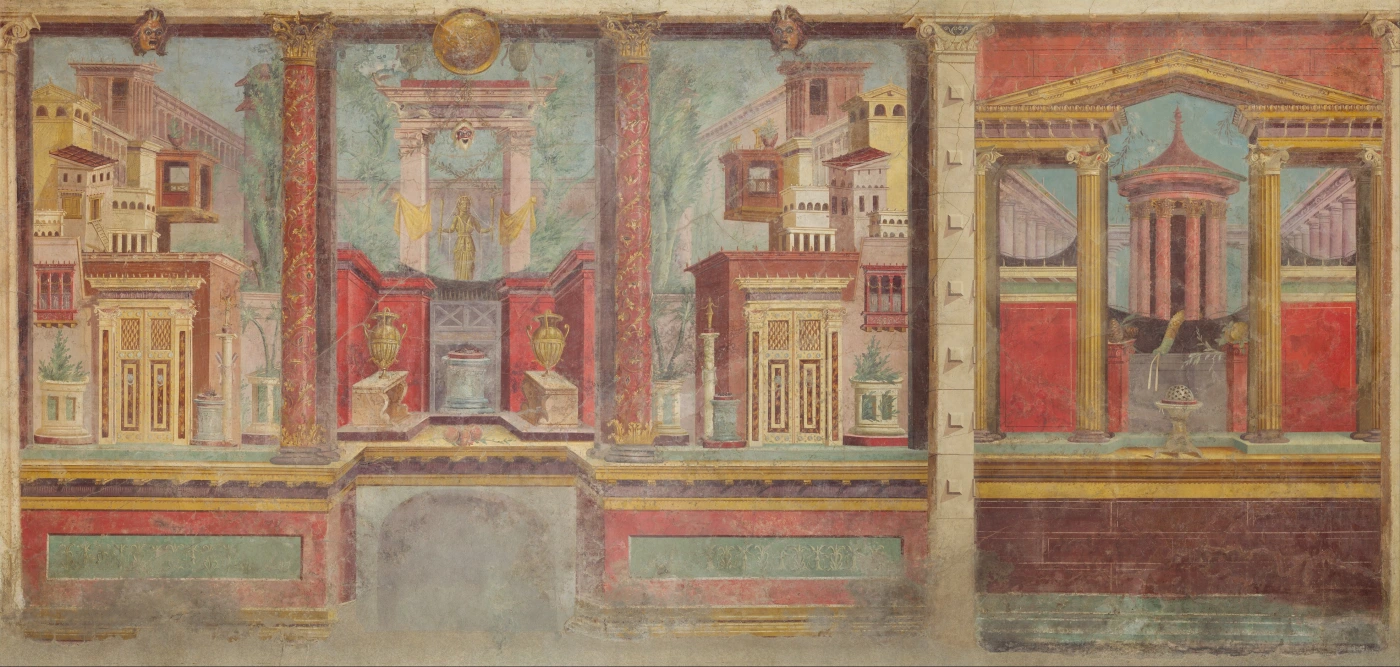De Artibus Romanorum III
If the accepted datings and chronologies are correct, then the short history of mural painting in Campania is one of the most eccentric, dynamic and imaginative in western art. The parameters of the problem were first articulated Die Geschichte der dekorativen Wandmalerei in Pompeji (1882) by the archaeologist and librarian August Mau. In this lavishly-illustrated survey of the Roman frescoes preserved by the eruption of Vesuvius in A.D. 79, Mau identified four distinct styles in use during the late Republic and early Empire. It is important to note that in Mau’s system, the four styles were developed sequentially, but they were, in some sense, practiced simultaneously.
The history of Roman wall painting is complicated by the fact that the pace of stylistic development increases geometrically. The First “Incrustation” Style, was the Samnite style, used without much change in the second and early first centuries B.C. The Second “Architectural” style, was introduced at the time of the Roman annexation of Pompeii in 80 B.C., and dominates the remainder of the first century B.C. The Third “Ornate” Style has as shorter run, from about 10 B.C. through the middle of the first century . The Fourth “Intricate” Style, introduced around A.D. 60, has a brief heyday in Pompeii until it is cut short by the cataclysm of A.D. 79. Outside of Campania, the all four styles continued to be used, with the Fourth being the most popular.
While the duration of the styles diminishes from longest to shortest, the styles themselves follow no rational development; instead they reverse each other and differ from each other wildly:
The First Style, exemplified by the fauces of the House of Sallust in Herculaneum, and illustrated above by a plate from Mau’s book, is a stucco and paint of a imitation of the multi-colored marble incrustation used in Ptolemaic and Hellenistic palaces. Designed to make ordinary walls look like expensive walls, the style appealed to prosperous, pretentious Samnites. The fictive marble of the socle zone, however, is continued through the other three styles;
The Second Style replaces the literal-minded mimesis of the First with illusionism. Using perspectival and naturalistic effects, the artists created not a fictive wall, but a fictive view through the actual wall into an implied space. The creators of magisterial Second-Style frescoes the Villa of P. Fannius Synistor at Boscoreale and the Villa A at Oplontis used depictions of monumental architecture, which seemed to project and recede, to dissolve the walls of the room and offer the viewer a fantasy experience of expansive, unbounded vision (a perfect visual metaphor of the ideology of the early Empire). The famous triclinum frescoes from the Villa of Livia at Primaporta take Second Style illusionism to the farthest extreme, reducing the architectural elements to a few palings and low walls and presents the viewer with an uninterrupted panorama that completely negates the wall;
The Third Style, which began as the court style of Augustus and Agrippa, rejects and, at times, seems to rebuke the pomposity and intellectual deceptions of its precursor. It does so by emphasizing the decorative nature or mural painting, underscoring the opacity and flatness of the wall, without ever lapsing into the ersatz reality of the First Syle. The Second Style’s fictive window opening on to hazy, late afternoon vistas of fruit trees and shrines in garden courtyards is slammed shut by the the Third Style’s unbroken walls soaked in impenetrable, monochrome pigments. The provocations do not end there: the firmly-grounded, monumental, fictive architecture of the Second Style is displaced by precious images of perversely miniaturized, delicate structures that exist outside of an definable spatial setting. The framing devices consist of architectural elements super-attenuated to the point of deformity and deployed in irrational structures. As unappealing as this may sound, the stunning frescoes of Cubicula 15 and 16 of the imperial Villa of Agrippa Postumus at Boscotrecase and Caldarium 8 at Oplontis Villa A show, the overall effect of the Third Style is one of severe elegance and tasteful restraint, the Roman equivalent of the Less-is-More aesthetic;
The Fourth Style, is both a reaction to the asceticism of the previous style and a lunatic synthesis of the dialectical oscillations that proceed it. It was developed by Nero’s court painter, Fabullus at the Domus Aurea. The More-is-More principle that guided the design of the 300-room palace extends to the Fourth Style, in which a profusion of clearly quoted elements of Styles 1-3 are recombined and multiplied to create complex, quasi-architectural, semi-realistic systems of imagery. The sensory overload and ostentatious display of pictorial wealth seen in extravaganzas like the Domus Aurea or the Ixion Room in the House of the Vettii dismayed purist theoreticians like Vitruvius, but clearly delighted everyone else from Nero’s mistress Poppaea to Cicero to wealthy parvenus like the Vettius brothers. Finally, the Fourth Style is a microcosm of Mau’s theory: it was the last style in a succession of four, and yet within it, those four styles are practiced at the same time.
To the Mau paradigm, one might append three reminders: 1) The Romans believed that paintings on buildings should refer to or depict buildings; 2) the hectic and productive development of Pompeiian painting was artificially truncated by a natural disaster–a Fifth or Sixth Style might have emerged had the winds blown in a different direction and 3) one-third of Pompeii, two-thirds of Herculaneum, and most of the Domus Aurea remain unexcavated.

This work is licensed under a Creative Commons Attribution 4.0 International License.



















Leave a comment